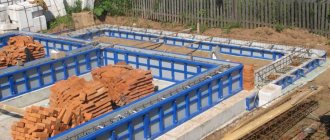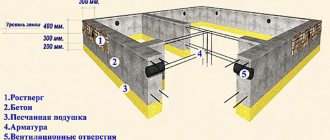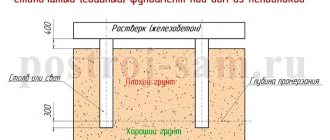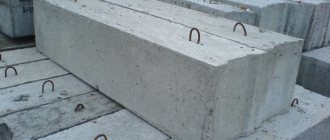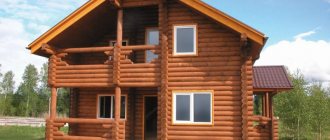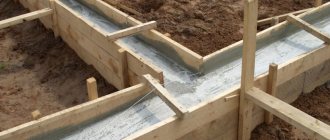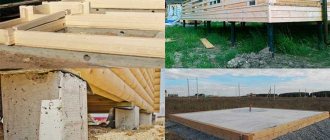Before the start of construction, it is recommended to develop a project in which information regarding the characteristics of the object must be indicated. The decision must contain information about the width of the base of the foundation, the level of its depth, the dimensions of the supporting base, and the building materials required for construction. The height of the foundation above ground level is also considered an important parameter, and you should not skimp on it. This part of the base is not only an architectural feature of the building, it also creates security for the load-bearing structures.
Foundation for a wooden house - SNiP, GOST, regulatory documents
Foundation for a wooden house
Construction of the foundation begins with calculations and familiarization with the requirements. Among the documents that regulate certain aspects of foundation construction are:
- GOST 13580-85 “Reinforced concrete slabs for strip foundations”.
- SNiP 3.02.01-87 “Earth structures, foundations and foundations.”
- SNiP 2.02.01-83 “Foundations of buildings and structures.”
- SNiP 2.02.03-85 “Pile foundations”
- SP 50-101-2004 “Design and installation of foundations and foundations of buildings and structures.”
- Guidelines for the design of foundations and foundations on heaving soils.
- Other regulations (regional or those that relate to work on specific types of soil).
It is worth noting that the recommendations given in the regulations and standards only determine the requirements for the construction process at key points. But a private house may differ in size, number of floors, and construction materials. Accordingly, the installation of a foundation for a wooden house will have a lot of variations used in each specific case. However, it must be taken into account that the foundation must exceed the ground level by 500 mm.
Parameters that determine height
In the design calculation, the minimum height above the ground of the building's foundation is determined by a complex of factors present. You can display the required value for the selected type of base if you know the following parameters:
- materials for construction;
- soil characteristics;
- presence of a basement;
- snow depth;
- groundwater levels, storm water levels;
- freezing depth.
In practice, the minimum of 0.2 m is rarely observed; more often, a lifting height of 0.35 m - 0.4 m is prudently chosen. In cases where the building is erected on an area with clay soil, the height can reach 0.8 m -0.9 m On sandy soils, 0.5 m is usually sufficient.
The height of the slab foundation, depending on the total weight of the building, will be from 0.2 m to 0.4 m.
In a monolithic MZLF, vents are installed for ventilation, which have established standard dimensions, and this also affects the height of the above-ground part. Water should not flow into them and small rodents should not crawl into them, so they are located at a level of 20 cm and above.
Products on the tape
The level location of such openings can be seen in this photo:
The easiest way to maintain the optimal height is to build the base on screw metal piles. It will not require a large amount of excavation work, costs for formwork and special construction equipment. The pile is screwed in manually. To strengthen the structure, concrete is poured inside.
Each pillar can have a different immersion depth when achieving reliable support on solid layers of rock. The height of the pipe remaining above ground level makes it possible to take into account the terrain and cut all elements into a single horizon after the entire pile field has been assembled.
The required rigidity is additionally ensured by tying with a grillage and, if necessary, scalding with bevels.
Add-ons
For a rough estimate, it is assumed that the cost of the foundation is about 30% of the total estimate for building a house. You can save on the consumption of materials for any type of foundation at the height of the structure above the ground.
The design calculation of a screw foundation for buildings consisting of light frames, log houses, prefabricated panels is not very difficult. Work is carried out at any time of the year, on sites of any terrain (except for rocky and rocky soils). When the site is densely built, without causing damage to nature in the forest or on the river bank, small holiday houses, bathhouses, gazebos, and fences are often placed on screw supports. Building a dacha on high pillars allows you to make good use of the space underneath (summer kitchen, car parking).
For monolithic solutions and brickwork, a standard of 10 cm in excess of the snow cover characteristic of a given climatic region is used.
How to determine in practice, using a water level, what the actual height difference of a monolithic strip foundation is, can be found in this video:
When marking and installing the support, it should be remembered that the height of the foundation at each point must be such that the upper plane has deviations from the horizontal surface no more than permissible values.
Construction of a foundation for a wooden house
To answer this question, you need to consider the factors that determine the type of foundation:
- location of the house . It is the starting point for all subsequent geological surveys. It is important not to build a house near cliffs, ponds, or unstable soils. And also take into account in advance the possibility of connecting to communications (gas supply, electrification, water supply);
- dimensions and number of floors of the house . The greater the weight of the house, the stronger the foundation under it must be. But, at the same time, an increase in floors leads to a greater load on the foundation, but an increase in the total area of the house does not put forward such requirements, because the total load per unit area remains unchanged;
- designed basement, ground floor;
- terrain . With large unevenness, the construction of strip-type foundations will entail the need to remove a significant amount of soil;
- soil type and its bearing capacity . There are five types of soil. To determine the type of soil on a site, it is not necessary to contact special organizations; it is enough to observe the soil after rain;
- Clay soil slowly absorbs moisture and becomes crusty during drought.
- Loamy soil will absorb moisture quickly, but will dry completely only after a couple of days.
- Sandy will quickly absorb moisture, and you can start working almost immediately after the rain.
- Vegetation does not grow well on peat, and it takes a long time to dry out.
- Calcareous soil is able to quickly absorb moisture and is characterized by the appearance of a light gray tint to the soil during drought.
The type of soil determines its bearing capacity;
- depth of groundwater . The more moisture there is in the ground, in close proximity to the foundation, the greater the likelihood that the soil will swell when freezing/thawing;
- soil freezing depth . The base of the foundation must be below the freezing level of the soil;
- material consumption, timing and cost of work . Determined by the developer independently;
- aesthetics of the design . Also depends on personal preference. In any case, further covering the foundation of a wooden house with basement siding, plaster, etc. will achieve the desired effect.
Calculation and consideration of the above factors will allow you to select the desired type of foundation. Which foundation for a wooden house is better? You can choose the appropriate option after assessing all the factors described above.
Types and types of foundations for wooden houses
The low weight of wood suggests the use of the following types of foundation:
- tape;
- columnar;
- pile;
- slab.
BASE CONSTRUCTION
The ground section of the foundation can be made in several options:
· Sunken. An economical option for a plinth, typical for walls with a small thickness. Allows you to hide the protrusion using waterproofing material or a small layer of soil.
· Speaker. Requires more building materials. Provides reliable protection for a wooden house from cold air, but requires high-quality waterproofing and drainage.
· The base is flush with the wall. The most unfortunate and rarely used solution, requiring constant monitoring of the cut of the waterproofing layer.
MATERIALS
To build the above-ground part of the foundation, it is necessary to use durable materials - concrete, brick, various types of stone. In most cases, the base of a wooden house requires the installation of an armored belt. The number and thickness of reinforcing bars depend on the design of the building.
· For wooden houses, a base made of monolithic concrete is best suited. Its arrangement requires the installation of formwork and reinforcement cage.
· For a structure made of solid (not gas silicate!) brick, it is necessary to take material with high frost resistance.
· Using concrete blocks requires special skill. Between them there will certainly remain various voids, which must later be filled with cement mixture.
HEAT AND WATER INSULATION
High-quality heat and waterproofing are mandatory steps for arranging the basement of a wooden house. Insulation must be done with porous materials with minimal water absorption. For waterproofing, bitumen mastics or roll materials are suitable.
The height of the base and the features of its arrangement depend on many parameters. But under any conditions, the minimum level of the ground part should not be less than 20 cm. This will help protect the house from flooding and increase the “life” of the lower wooden crowns.
Strip foundation for a wooden house
Strip foundation for a wooden house
Strip foundation is one of the most common types of foundation. It has the same cross-section along the entire perimeter. Its width should be 50 mm. wider than the calculated width of the wall.
Subtypes of strip foundation:
Types of strip foundations for a wooden house
Deeply buried strip foundation. It is poured along the perimeter of the building and internal walls. Applies if:
- the soil on the site is classified as heaving;
- at a significant depth of soil freezing;
- when groundwater flows in close proximity to the soil surface;
- if there is a basement, ground floor, garage;
- in case of multi-storey construction.
Construction of a strip foundation for a wooden house
Construction technology:
- digging a pit. The depth of the foundation for a wooden house should exceed the soil freezing level by 200 mm. And the width is equal to the estimated width of the foundation, plus 400-500 mm. on formwork and ease of use;
- installation of a sand-cement cushion. To do this, a layer of mixture 150-200 mm thick is poured onto the bottom of the pit. To compact the mixture, you need to pour it with water and then compact it. Arranging a cushion will reduce the load on the foundation between seasons;
- installation of formwork. In order for the foundation surface to be level, you need to knock down the formwork from the inside and hammer the nails in from the outside. This technique will simplify the dismantling of the formwork.
Nuance. So that the dismantled formwork can still be useful, we advise you to choose the material for its construction based on further needs. For example, if you plan to use metal tiles as a roofing material, use cut boards for formwork. If bitumen shingles, then give preference to plywood. In this case, you need to fill the inside of the formwork with film. Thus, lumber can be used to construct a rafter system.
- To prevent the formwork from creeping under the pressure of concrete, spacers must be installed.
- installation of reinforcement. Metal rods can be laid in several rows. However, it should be remembered that welding work is not carried out when tying the reinforcement. The reinforcement bars are fastened to each other using wire;
- Pipes are installed between the fittings. They are needed for laying communications and ventilation.
- pouring concrete. Moreover, if the work lasts for several days, then each previous layer must dry. And the filling is carried out using the “wet” method.
Important. After each stage, you need to check the horizontal level with a building level.
Before starting construction of the building, the foundation must stand for several weeks. During this time, the foundation may sag and there will be time to fix the problems. Otherwise, shrinkage of the foundation will lead to shrinkage and deformation of the walls.
An alternative to a monolithic foundation is a block foundation. In this case, the blocks are laid out in several rows to the required height, fastened together with cement mortar and tied with reinforcing mesh.
Shallow strip foundation. MZLF is most often given preference in the construction of wooden houses. Since the weight of a wooden house is much less than a brick one.
The height of a shallow monolithic foundation ranges from 300 to 500 mm, therefore it is used in cases where it is necessary to reduce the cost of building a foundation without compromising its technical and operational characteristics.
A shallow foundation is used for temporary or light-weight small wooden buildings.
Tape base:
- The monolithic structure is deservedly popular among developers - the possibility of creating useful space in the basement, reducing costs.
- In severe winter conditions and freezing of the soil to a great depth, the size of the underground part will be up to 1.5 m.
- The base is arranged in accordance with its requirements - the installation of a furnace room, a basement. Boiler chambers require a precise approach, so the overall height is characterized by safe operation and regulated placement of equipment. That is, you won’t have to act in cramped conditions in case of emergency measures – fire, flood.
- For buildings made of wood, the heights of the basement floors always increase by an order of magnitude, regardless of terrain and soil conditions. Raw materials are capricious, and the higher they are raised above the ground, the more durable the object.
Thus, the optimal height of the strip foundation with the proposed boiler room will be about 2 m.
Columnar foundation for a wooden house
Columnar foundation for a wooden house
Material prepared for the website www.moydomik.net
The construction of a columnar foundation involves the use of concrete blocks, bricks, asbestos pipes, and pouring concrete into the formwork. It is used on heaving soils with a significant freezing depth. And also on uneven terrain and during the construction of houses that do not have a basement.
The use of such a foundation allows you to install the house on reliable ground and at the same time reduce concrete consumption. In this case, the pillars are installed at key points.
Construction of a columnar foundation for a wooden house
Construction technology:
- determine the location of the pillars. The distance between them depends on the length of the house, but should not be less than 1.5-2 m. It is mandatory to install pillars at the corners of the building, as well as at the junction and intersection of walls;
- deepen the pillar into the ground to a depth of 50-70 cm. A sand cushion under each pillar is a prerequisite for installing any type of support. If the pillar is manufactured at the installation site, it is necessary to make formwork and use reinforcement;
Advice. A more modern way to install poles would be to use TISE technology. It provides for the expansion of the support column at the bottom. This design is more durable and can be installed on any type of soil (excluding floaters). And easy installation allows you to speed up work and do without the use of equipment.
TISE foundation
- arrange a wooden or metal grillage on top of the pillars. Thanks to this, the load from the weight of the house will be evenly distributed between the supports.
Properties of a foundation with a high above-ground part
The height of the foundation of the house affects the appearance of the building, allows you to arrange utility lines in the basement that are easy to maintain, and also makes it possible to protect the structure of the house from adverse climatic influences, moisture and temperature changes.
Properties influencing structural and thermal characteristics
Consider the required height if the above-ground part of the foundation becomes a basement wall.
Why you need to increase the height of the foundation above ground level can be understood by studying the following points:
- The main supporting structure of the house, raised above ground level by increasing its vertical size, will be the base of the building. In this case, it will represent a homogeneous structure without a dividing seam, which is performed with horizontal waterproofing in the case of a separate base and foundation.
- A house with a high strip frame receives additional guarantees for protection against the harmful effects of water on the structure. To do this, the height of the house foundation must be determined based on the excess of the upper cut of the structure above the level of the highest possible snow level, taking into account the snowiest winters. But regardless of this, its height must be at least 30 cm.
- If the above-ground part of the foundation of the house is a basement wall, then its height is determined taking into account the design solutions included in the design documentation that affect its increase.
- When installing a columnar foundation and grillage using piles, in addition to the elevation of the upper part above the ground surface, the lower edge, resting on piles or on foundation pillars, should also be 20-30 cm above the ground level. This will protect the foundation beams and pile grillages from possible movements of the heaving soil during periods of alternating freezing and thawing.
- The height of the structure above ground level, calculated with a certain margin, during design will compensate for possible shrinkage of the base.
If the height of the foundation of the house above the surface is at least 30 cm, then the floor of the building is higher than the ground, which makes it possible to reduce the heat loss of it and the entire house without the use of additional measures for its insulation and without increasing the cost.
Properties affecting performance
A high foundation will make it possible to use the space under the floor.
If the house is made of structures that are especially susceptible to the negative influence of moisture and other environmental influences, for example, wood, then the high structure of the frame will create additional conditions for protecting the material from contact with water and for ventilation, which will ensure the creation favorable conditions for the proper operation of the building.
The presence of a foundation above ground level in a basement-free room makes it possible to use the additional space below the floor created by this for the location of water supply, sewerage, gas pipelines and other engineering systems.
When the height of this space is below the floor, allowing a person to be there and fully perform certain operations, the operation and repair of these networks and systems becomes accessible, convenient and reliable.
Having examined and analyzed the positive details when constructing a high foundation for a house, we can conclude that its use is economically feasible.
Pile foundation for a wooden house
Pile foundation for a wooden house
Wooden houses on pile foundations are built on unstable soils and uneven terrain. Another prerequisite is a high or constantly changing groundwater level. In addition, a pile foundation is a great way to reduce the cost of building a house and increase its maintainability.
Nuance. This type of foundation is not suitable for a basement. And, in addition, many practitioners argue that such a foundation is not suitable if it is planned to build a garage on a common foundation with the house. A large slope makes it difficult to enter the garage, especially in bad weather conditions.
The technology for pouring a pile type foundation is similar to a columnar one. The pile-screw foundation is different, in the construction of which metal screw piles are used. The difference is that in this case the supports are not dug into the ground, but are screwed into place. Because the pile has a drill at the end, which allows you to drill the soil to a depth below the freezing level. This simplifies work and reduces installation complexity and cost. Next, the pile is filled with concrete.
Nuance. There are known cases when frozen soil undermined the pile, so experts recommend making its side surface smooth. A film or asbestos pipe is suitable for this.
A grillage is also installed between the piles.
Types of foundations for wooden buildings.
Types of foundation for a wooden house.
Scheme of foundation types for wooden houses.
A wooden house, depending on the shape of the building and the specifics of the soil on the site, can be erected on one of three types of foundation:
The strip construction is ideal for the construction of a large building with thick walls and a basement. In addition, it can be used as a basis for a light wooden structure, which is planned to be erected on non-heaving soil. If the soil is not dry enough and freezes strongly, it is recommended to choose other structures, since erecting a strip foundation in this case is impractical.
A strip foundation, characterized by its high strength and long service life, is recognized as the best and most profitable option for building a house made of wood. The tape structure can be prefabricated or monolithic. To make the first type, blocks are used, the thickness of which is 30-60 cm. The very first row of such a foundation is placed on a concrete pad 10 cm thick, after which the remaining rows are installed. The vertical seams are spaced apart. The strength of the prefabricated structure depends on the number of vertical and horizontal joints; the more there are, the lower the waterproofness of the base.
Therefore, when starting to build such a foundation, you need to take care of its waterproofing in advance, which will increase the total cost of construction. It is for this reason that preference is most often given to a monolithic type strip foundation. Such a basis does not require professional knowledge or high costs from the performer. The main thing is to carefully study the features of its device.
Slab foundation for a wooden house
Slab foundation for a wooden house
A slab foundation for a wooden house is used where difficult soils are present. The mobility of such soils is leveled by the production of a monolithic reinforced concrete slab, which is equal to the area of the house. A significant advantage of the slab is that it is movable, which means that the house is not deformed by the movement of the soil underneath it.
Pouring a slab foundation is a very costly and troublesome undertaking, consisting of the following stages:
- digging a pit. Due to its size, it will be necessary to attract additional equipment;
- arrangement of sand-cement cushion;
- laying of reinforcement;
- pouring concrete.
A particular difficulty in the construction of such a foundation is ensuring uniform drying of the concrete over the entire surface of the slab.
Effect of altitude
The planting depth of the base plays a significant role. It protects the cosmetic finishing of rooms from mechanical damage during snow removal and other work carried out to clean up the territory.
Installing a drainage system to drain groundwater from the foundation: the easiest way to drain water from the houseRules for choosing workwear for builders: an overview of all the features
Brick foundation - main applications, construction stages and tips for strengthening the foundation (105 photos and videos)
It serves as an important indicator that influences the mechanism of operation of the drainage system, which is necessarily implemented in cases where construction takes place near reservoirs or areas located in lowlands.
For a dwelling made of wooden beams, the elevation of the base is of great importance. Since rotting of the lower part of the crown is the main problem. The gap between the floor and the ground affects the thermal insulation characteristics and the lifespan of the ceiling.
What kind of concrete is needed for the foundation of a wooden house
Normative documents:
- GOST B V.2.7-44-96 “Cement”.
- GOST B V.2.7-46-96 “Cements for general construction purposes”.
- GOST V.2.7-65-97 “Additives for concrete and mortars”.
- GOST V.2.7-69-98 “Additives for concrete. Methods of determination".
In short, when choosing cement for concrete, you need to take into account the characteristics of the soil, the expected load, the type of foundation, and the height of the groundwater.
As for the brand of cement, the M150 brand is suitable for wooden one-story houses. However, professionals advise not to skimp on the brand and purchase cement with a grade of at least M400. In this case, preference should be given to Portland cement with additives, which has the necessary properties.
You can make concrete with your own hands based on M400 cement using the data in the table, where C is cement, P is sand, Sh is crushed stone.
When building a wooden country house or cottage, special attention should be paid to waterproofing the foundation. To prevent cracking of the foundation, after pouring it is treated with various compounds (for example, Penetron) or bitumen-based films. Waterproofing allows you to protect the foundation from water (ground, melt, rain).
An additionally filled blind area near the house will drain water and preserve the foundation. The ebb on the foundation of a wooden house will also provide excellent protection from moisture. It is mounted in such a way that it protects the base of the building.
Low tide on the foundation of a wooden house
How do the parameters of the foundation compare?
As an example, let’s look at how the parameters of the foundation are calculated when building an individual house.
Practice shows that the ratio of the height of the above-ground base to the width is 1:4.
The structure of a classic shallow foundation does not imply the presence of a base. The height of the foundation above ground level does not exceed the underground part, but the opposite option occurs quite often.
If the soil at the construction site has standard characteristics, usually the height and depth are the same and do not exceed 0.5 m.
